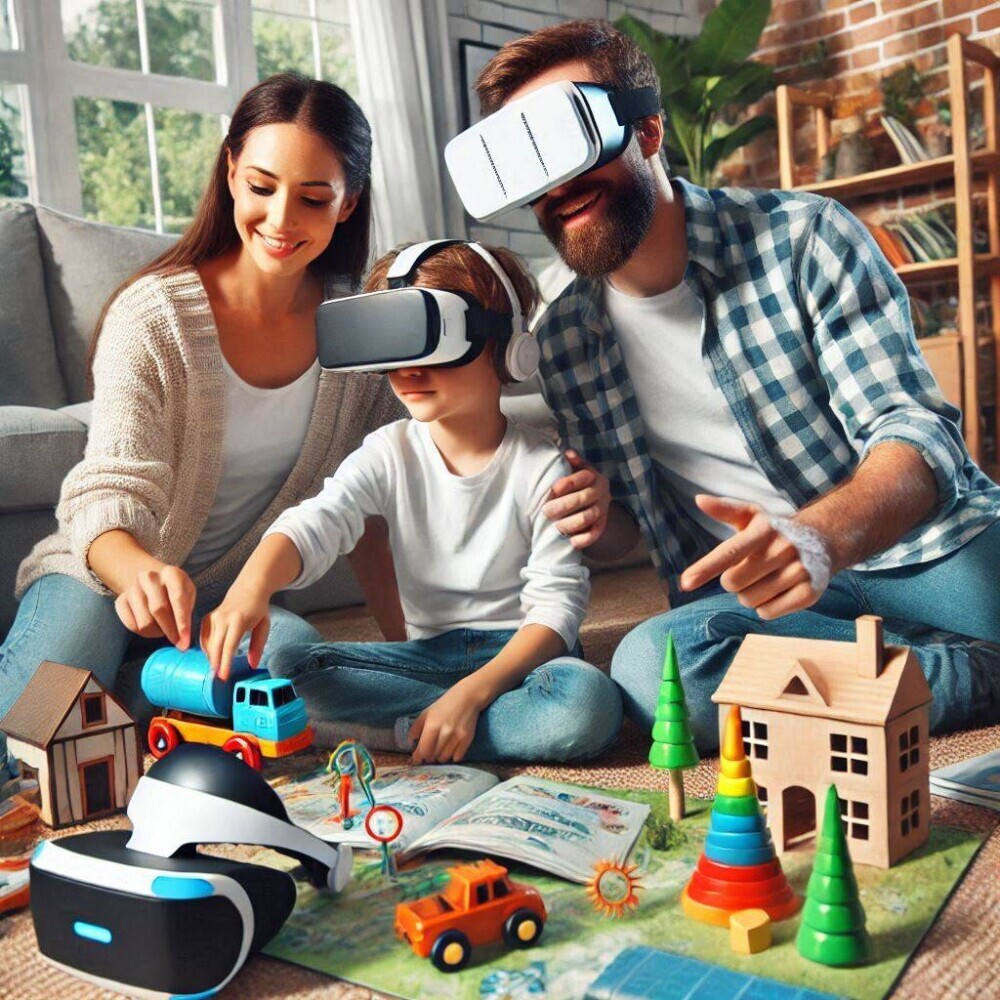This post may contain affiliate links. When you click and purchase from any of our links, we may get a small commission at no extra cost to you. For more information, please see our affiliate disclosure.
Picture this: a home-based classroom where kids are as eager to learn as they are to play their favorite games. Game-based learning has come a long way, morphing from simple educational games into complex curriculums. It’s fascinating to see how this approach has evolved.
Way back, education was mostly about chalkboards and rote memorization. But now, innovative teachers and passionate game developers have flipped the script. They saw a golden opportunity to combine learning with fun by harnessing the power of games. This vision started with simple edutainment titles designed to make learning enjoyable.
As more educators noticed the prospects, the integration of games into education picked up steam. Not just school teachers, but experts across fields began acknowledging this method’s potential. And it wasn’t long before schools started experimenting with more structured game-based curriculums.
One can’t ignore the active participation and enthusiasm when kids solve puzzles in a math game or explore a virtual world for history lessons. It’s this active learning that sets game-based education apart. It offers an engaging and interactive alternative to conventional textbooks.
Around the globe, there are already great examples of this approach in action. Schools featuring gamified science labs or interactive language games show that lessons can be learned more effectively in a playful setting. These real-world cases highlight the transformative potential of game-based learning and its role in shaping the future of education.
The Impact of Game-Based Learning on Child Development
Imagine this: your kids eagerly diving into math, history, or science lessons with the same excitement they have for their favorite games. Sounds like a dream, right? But it’s entirely possible with game-based learning—a method that brings education and fun together seamlessly in your homeschool.
Kids today are growing up in a world where interacting with technology is second nature. Game-based learning taps into this reality, offering a way to harness children’s natural affinity for games in developing essential skills.
Research shows that interactive learning through games can significantly boost cognitive skills. Kids get to think critically, make decisions, and see the consequences of those choices unfold. This isn’t a passive sort of learning. They’re actively engaged, solving problems, and applying what they’ve learned in real-time scenarios.
Games can be catalysts for improving problem-solving abilities. Picture a child tasked with navigating a character through a maze or solving a complex puzzle. These activities require strategic thinking and honing the skills needed to tackle new challenges.
Creativity and critical thinking get a solid workout too. Many educational games encourage kids to explore various pathways to achieve goals. By allowing creative problem-solving, kids learn to embrace innovative thinking and develop a mindset that’s open to exploring different perspectives.
Finally, let’s not overlook the social and emotional benefits. Playing games often means working in teams or competing in friendly battles. These experiences help children learn important life skills such as teamwork, communication, and managing emotions under pressure.
Game-based activities also allow kids to experience setbacks in a safe environment, teaching resilience and perseverance. The emotional growth and social skills gained are just as valuable as the academic knowledge.
In the past, learning at home often relied on workbooks and repetitive drills, but game-based learning changes everything. It taps into children’s natural love for play, turning lessons into adventures. This isn’t just about sneaking in a little fun; it’s about using the magic of gaming to inspire curiosity and creativity.
Crafting an Effective Game-Based Learning Curriculum
Creating a game-based learning curriculum isn’t just about throwing a few fun activities together. It’s about crafting an experience that both educates and engages students. Successful implementations marry educational content with captivating game mechanics to foster a love for learning.
To kick things off, defining clear learning objectives is critical. Every game, every task, has to steer kids toward mastering new concepts or skills. The magic happens when these objectives are seamlessly woven into the game’s narrative and tasks, making learning feel like a natural and enjoyable adventure.
An effective game-based curriculum understands the balance between fun and education. It doesn’t just entertain; it educates by leveraging the game’s mechanics to reinforce lessons. Think of math games where students solve puzzles by applying formulas or history games where players step into the shoes of historical figures to understand different perspectives.
Personalized learning paths make a huge difference, too. Not every kid learns the same way or at the same pace. So, including options that allow students to navigate their educational journey with some autonomy can really boost engagement and cater to individual learning needs.
But it’s not all fun and games—there’s a need to ensure curriculum alignment with educational standards. This guarantees that while students are having a blast, they’re also meeting the requirements of their educational system. Coordination with curriculum developers and educators can keep the content grounded in educational value.
The idea isn’t to just add a game here or there; it’s about creating a cohesive, intentional learning experience. Think of it as designing a quest for your homeschooler.
- Start with a Goal: Decide what you want your child to achieve. Maybe it’s mastering multiplication tables or understanding ancient civilizations.
- Find Games That Fit: There’s a game for nearly every subject—math puzzles, history simulations, even coding adventures.
- Blend Fun with Education: The best games feel like play but are rooted in real learning objectives.
- Personalize the Journey: Every child learns differently. Find games that let them explore topics at their own pace.
- Align with Your Curriculum: While games should be fun, they also need to cover essential skills and concepts. This ensures your homeschool stays on track.
How Game-Based Learning Benefits Your Homeschool
Let’s be honest, keeping your child engaged in learning can be a challenge. Game-based education makes it easier by meeting your child where they’re already excited—playing games.
Sharpens Thinking Skills: Picture your child navigating a virtual maze or solving a tricky puzzle. They’re not just having fun; they’re building critical thinking and decision-making skills.
Enhances Problem-Solving: Every challenge in a game is an opportunity to think strategically, an essential skill for any learner.
Boosts Creativity: Games often encourage unique solutions. Your child gets to experiment, think outside the box, and discover that there’s more than one way to succeed.
Builds Emotional and Social Skills: Whether working as part of a team or managing the disappointment of losing, games teach resilience, communication, and empathy—all while fostering emotional growth.
Your homeschool can become a place where learning feels like an adventure instead of a chore.
Future Trends and Technologies in Game-Based Education
Game-based learning is on the brink of exciting transformations, driven by new tech and educational needs. Emerging tools and platforms are setting the stage for a fresh wave of innovation in classrooms. As educators and developers continue to experiment, a few promising trends are catching the limelight.
Artificial intelligence (AI) is boosting the personalization aspect of game-based curriculums. By analyzing a student’s progress and adapting to their learning pace and style, AI tools can create customized experiences tailored to individual needs. This personalized approach helps ensure that no learner is left behind. Imagine a game that adapts to your child’s learning pace and style, ensuring they’re always challenged but never overwhelmed.
Augmented reality (AR) and virtual reality (VR) are opening new avenues for immersive learning experiences. From exploring the pyramids to diving into coral reefs, VR and AR make the impossible possible in your homeschool. Such experiences make learning tangible and memorable, offering depth that traditional methods may lack.
Find the best VR or AR system for your homeschooling family on Amazon
Collaborative, multiplayer educational experiences are gaining traction. These interactive environments foster teamwork and communication, mirroring the collaborative nature of most workplaces. By working together to solve problems or complete tasks, students can build not only knowledge but also essential social skills. Multiplayer games also let siblings or homeschooling co-op groups work together to solve problems and complete missions.
Looking ahead, we can expect game-based education to become even more integral to learning environments worldwide. Benches and blackboards might still have their place, but digital learning platforms will continue to innovate, ensuring educational experiences are engaging, effective, and aligned with the future of work.
Final Thoughts
Game-based learning is more than just a way to keep your kids entertained; it’s a tool to make homeschooling dynamic and memorable. It turns lessons into stories, challenges into opportunities, and learning into play.
So why not give it a try? Start small, explore what works for your family, and let your homeschool transform into a space where fun and education go hand in hand.
Your next great homeschool adventure is just a game away!
Additional Resources
- Article: Free Homeschooling Resources You Can Start Using Today
- Homeschooling supplies on Amazon HERE
When you click and purchase from any of our links, we may get a small commission at no extra cost to you. For more information, please see our affiliate disclosure.


